Organisational Behaviour Report: Individual and Team Performance
VerifiedAdded on 2020/10/23
|19
|6722
|203
Report
AI Summary
This report delves into the realm of organisational behaviour, examining how an organisation's culture, politics, and power dynamics influence individual and team behaviour and performance. Using A David & Co. Limited as a case study, the report analyses the impact of different cultural models, such as Handy's typology, and explores the positive and negative effects of organisational politics and power structures. Furthermore, the report evaluates various motivation theories and techniques to achieve organisational goals and explains the characteristics of effective and ineffective teams. Finally, the report applies concepts and philosophies of organisational behaviour within the context of the given business situation, providing a comprehensive understanding of how these factors interact to shape workplace dynamics and overall organisational success.
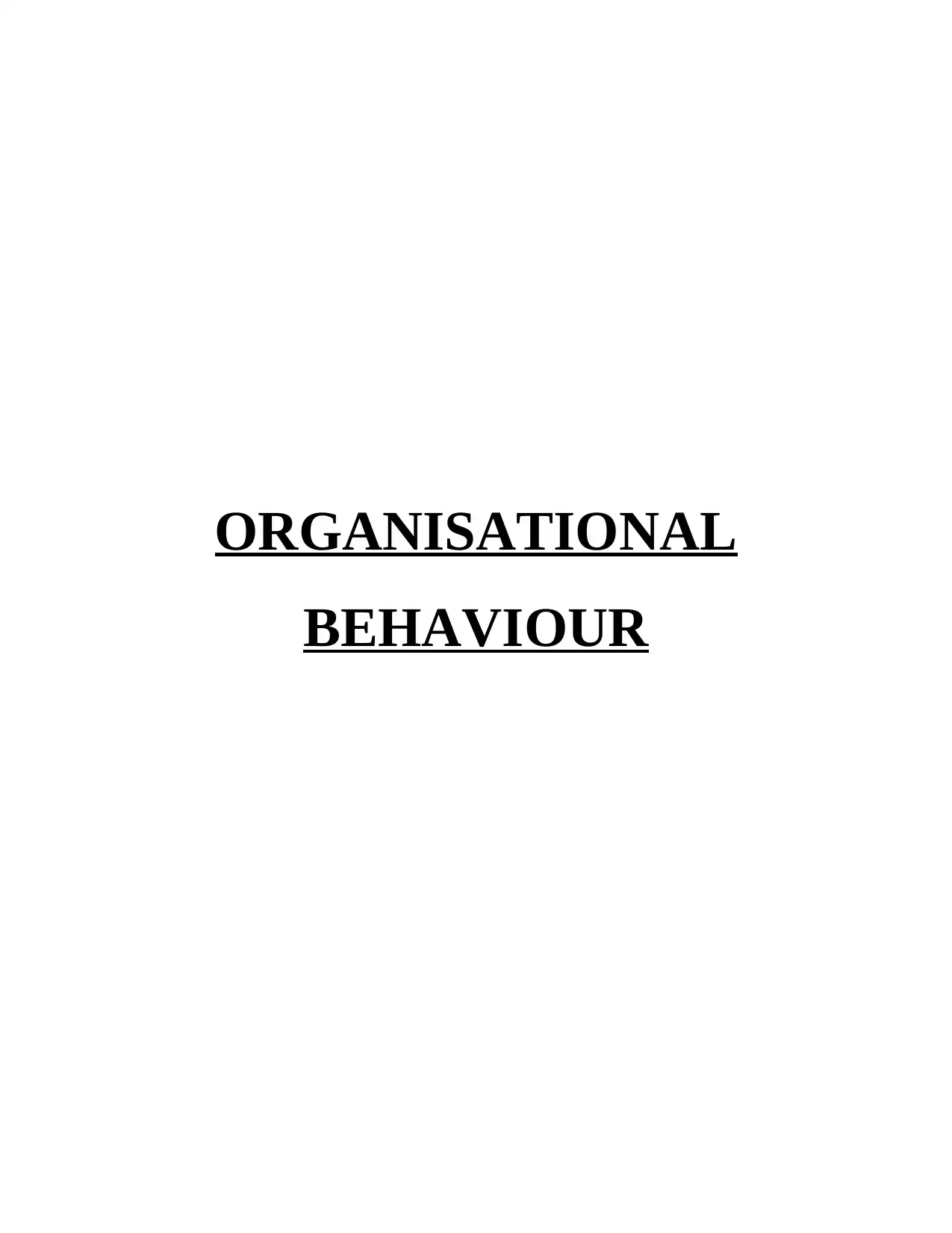
ORGANISATIONAL
BEHAVIOUR
BEHAVIOUR
Paraphrase This Document
Need a fresh take? Get an instant paraphrase of this document with our AI Paraphraser
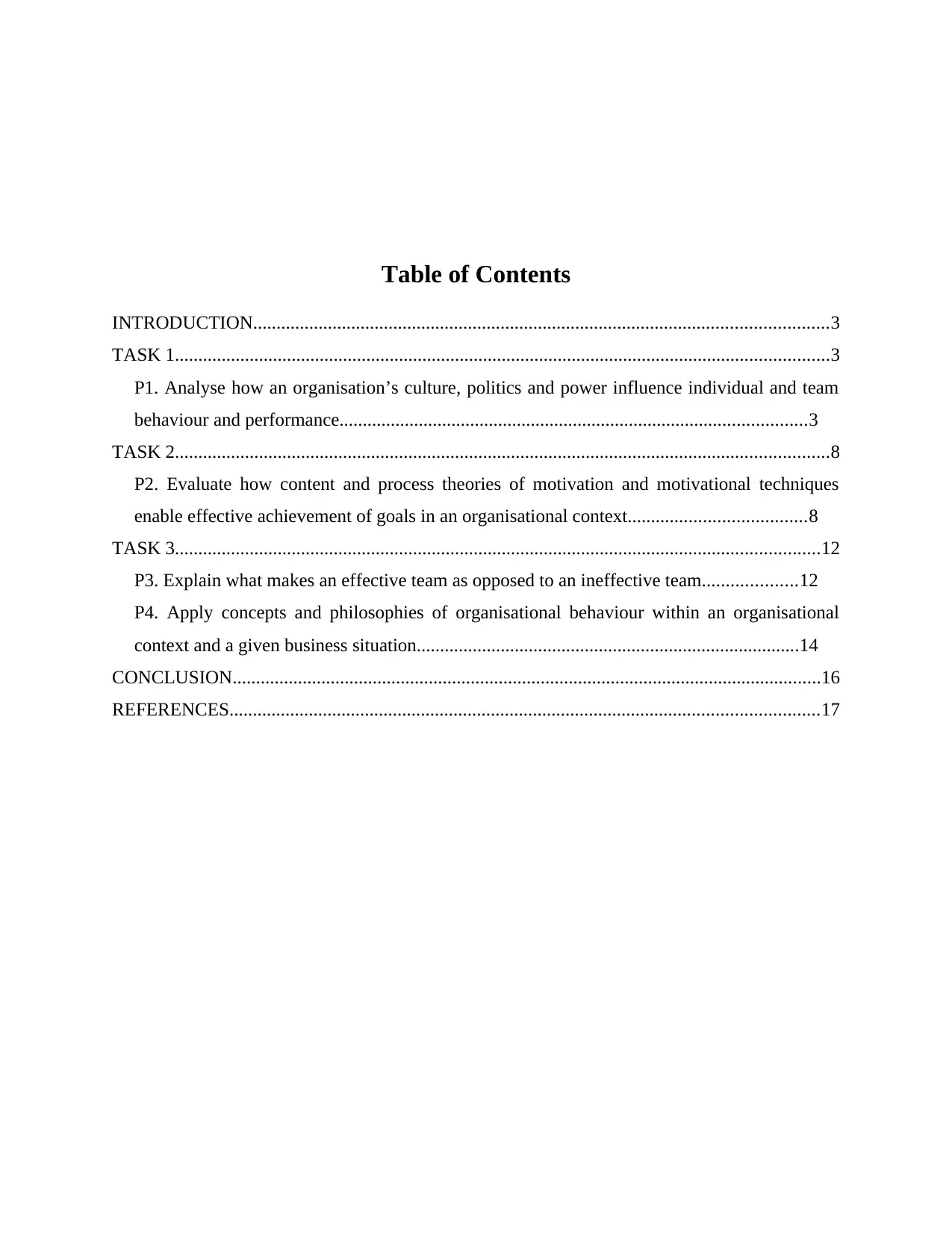
Table of Contents
INTRODUCTION...........................................................................................................................3
TASK 1............................................................................................................................................3
P1. Analyse how an organisation’s culture, politics and power influence individual and team
behaviour and performance....................................................................................................3
TASK 2............................................................................................................................................8
P2. Evaluate how content and process theories of motivation and motivational techniques
enable effective achievement of goals in an organisational context......................................8
TASK 3..........................................................................................................................................12
P3. Explain what makes an effective team as opposed to an ineffective team....................12
P4. Apply concepts and philosophies of organisational behaviour within an organisational
context and a given business situation..................................................................................14
CONCLUSION..............................................................................................................................16
REFERENCES..............................................................................................................................17
INTRODUCTION...........................................................................................................................3
TASK 1............................................................................................................................................3
P1. Analyse how an organisation’s culture, politics and power influence individual and team
behaviour and performance....................................................................................................3
TASK 2............................................................................................................................................8
P2. Evaluate how content and process theories of motivation and motivational techniques
enable effective achievement of goals in an organisational context......................................8
TASK 3..........................................................................................................................................12
P3. Explain what makes an effective team as opposed to an ineffective team....................12
P4. Apply concepts and philosophies of organisational behaviour within an organisational
context and a given business situation..................................................................................14
CONCLUSION..............................................................................................................................16
REFERENCES..............................................................................................................................17

⊘ This is a preview!⊘
Do you want full access?
Subscribe today to unlock all pages.

Trusted by 1+ million students worldwide
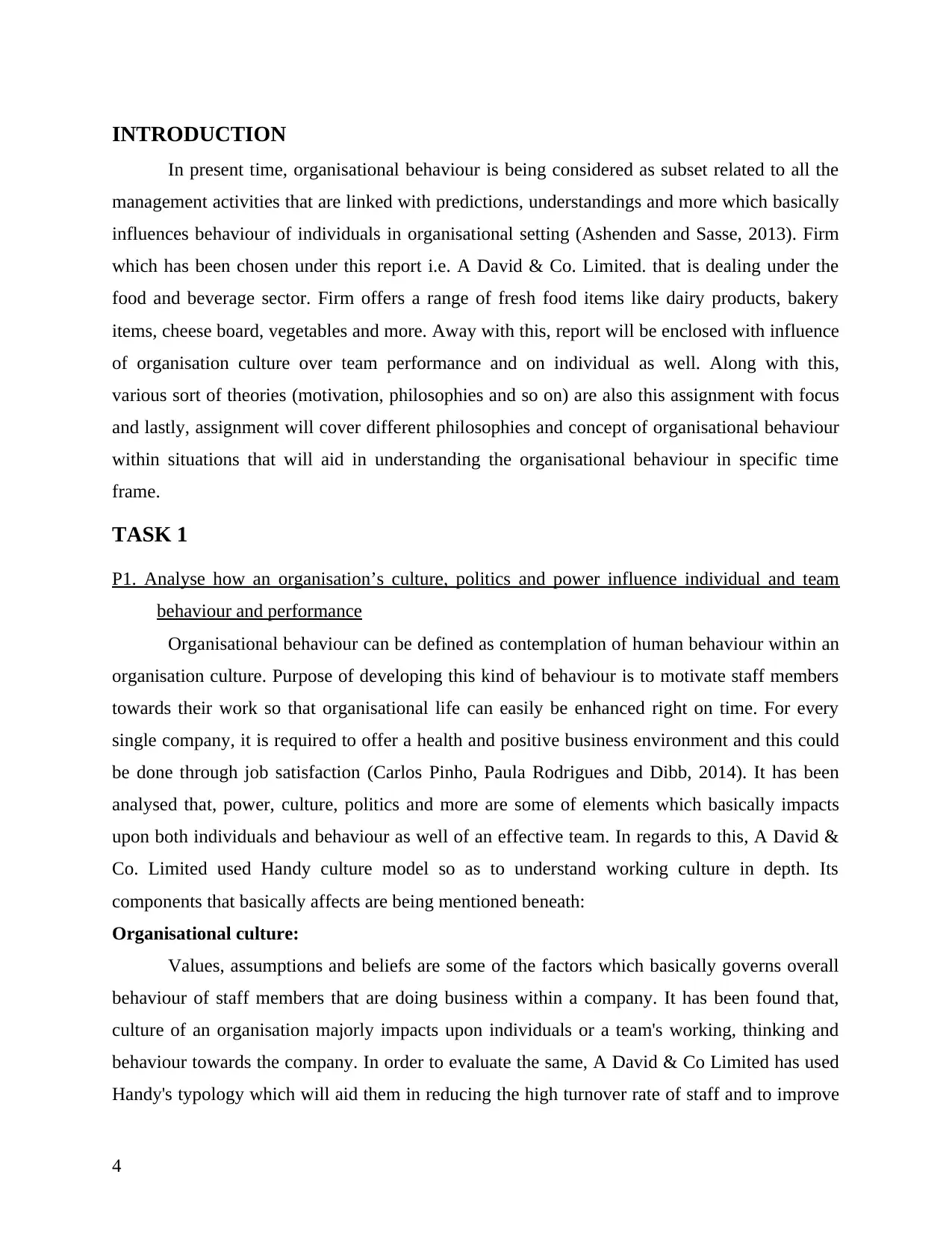
INTRODUCTION
In present time, organisational behaviour is being considered as subset related to all the
management activities that are linked with predictions, understandings and more which basically
influences behaviour of individuals in organisational setting (Ashenden and Sasse, 2013). Firm
which has been chosen under this report i.e. A David & Co. Limited. that is dealing under the
food and beverage sector. Firm offers a range of fresh food items like dairy products, bakery
items, cheese board, vegetables and more. Away with this, report will be enclosed with influence
of organisation culture over team performance and on individual as well. Along with this,
various sort of theories (motivation, philosophies and so on) are also this assignment with focus
and lastly, assignment will cover different philosophies and concept of organisational behaviour
within situations that will aid in understanding the organisational behaviour in specific time
frame.
TASK 1
P1. Analyse how an organisation’s culture, politics and power influence individual and team
behaviour and performance
Organisational behaviour can be defined as contemplation of human behaviour within an
organisation culture. Purpose of developing this kind of behaviour is to motivate staff members
towards their work so that organisational life can easily be enhanced right on time. For every
single company, it is required to offer a health and positive business environment and this could
be done through job satisfaction (Carlos Pinho, Paula Rodrigues and Dibb, 2014). It has been
analysed that, power, culture, politics and more are some of elements which basically impacts
upon both individuals and behaviour as well of an effective team. In regards to this, A David &
Co. Limited used Handy culture model so as to understand working culture in depth. Its
components that basically affects are being mentioned beneath:
Organisational culture:
Values, assumptions and beliefs are some of the factors which basically governs overall
behaviour of staff members that are doing business within a company. It has been found that,
culture of an organisation majorly impacts upon individuals or a team's working, thinking and
behaviour towards the company. In order to evaluate the same, A David & Co Limited has used
Handy's typology which will aid them in reducing the high turnover rate of staff and to improve
4
In present time, organisational behaviour is being considered as subset related to all the
management activities that are linked with predictions, understandings and more which basically
influences behaviour of individuals in organisational setting (Ashenden and Sasse, 2013). Firm
which has been chosen under this report i.e. A David & Co. Limited. that is dealing under the
food and beverage sector. Firm offers a range of fresh food items like dairy products, bakery
items, cheese board, vegetables and more. Away with this, report will be enclosed with influence
of organisation culture over team performance and on individual as well. Along with this,
various sort of theories (motivation, philosophies and so on) are also this assignment with focus
and lastly, assignment will cover different philosophies and concept of organisational behaviour
within situations that will aid in understanding the organisational behaviour in specific time
frame.
TASK 1
P1. Analyse how an organisation’s culture, politics and power influence individual and team
behaviour and performance
Organisational behaviour can be defined as contemplation of human behaviour within an
organisation culture. Purpose of developing this kind of behaviour is to motivate staff members
towards their work so that organisational life can easily be enhanced right on time. For every
single company, it is required to offer a health and positive business environment and this could
be done through job satisfaction (Carlos Pinho, Paula Rodrigues and Dibb, 2014). It has been
analysed that, power, culture, politics and more are some of elements which basically impacts
upon both individuals and behaviour as well of an effective team. In regards to this, A David &
Co. Limited used Handy culture model so as to understand working culture in depth. Its
components that basically affects are being mentioned beneath:
Organisational culture:
Values, assumptions and beliefs are some of the factors which basically governs overall
behaviour of staff members that are doing business within a company. It has been found that,
culture of an organisation majorly impacts upon individuals or a team's working, thinking and
behaviour towards the company. In order to evaluate the same, A David & Co Limited has used
Handy's typology which will aid them in reducing the high turnover rate of staff and to improve
4
Paraphrase This Document
Need a fresh take? Get an instant paraphrase of this document with our AI Paraphraser
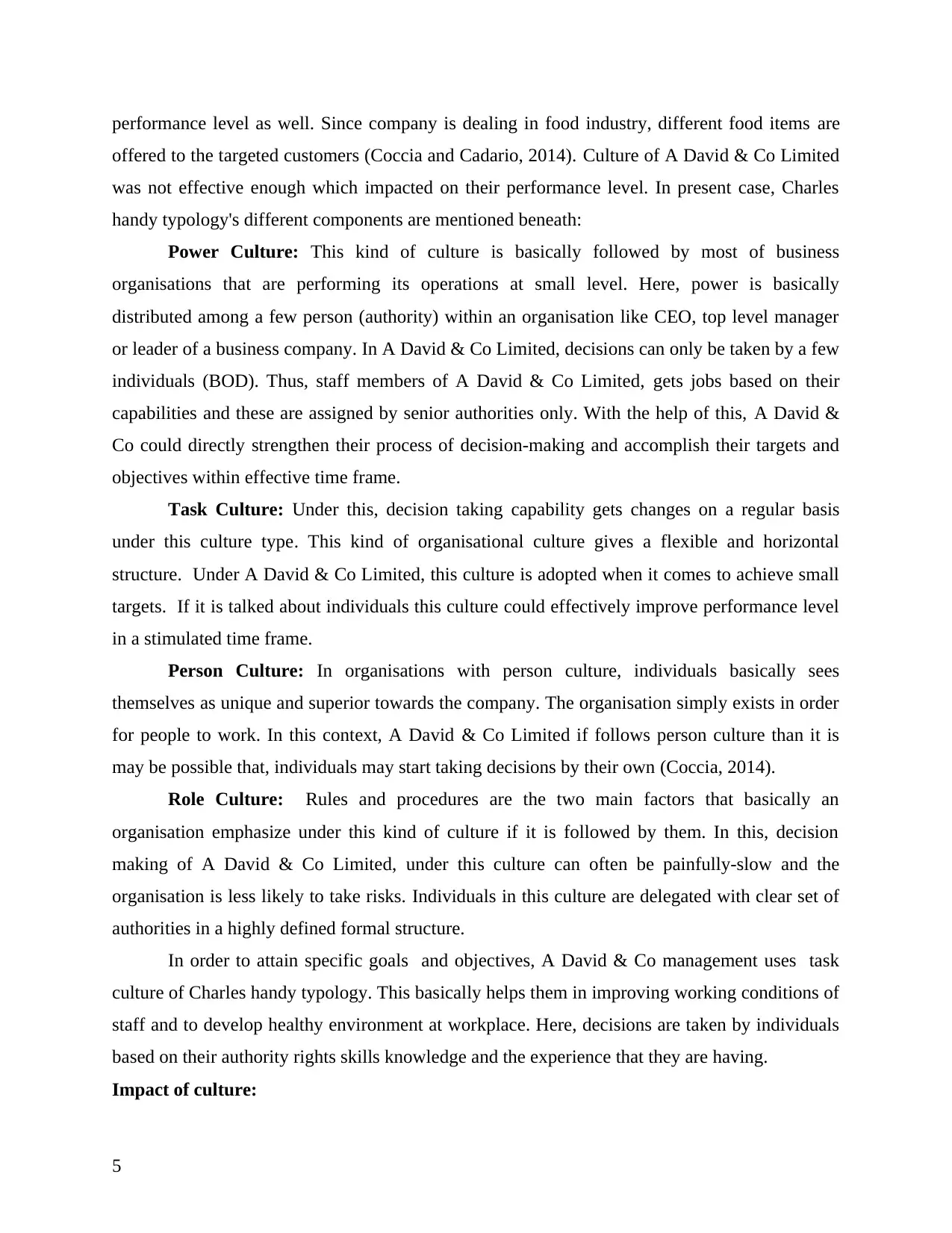
performance level as well. Since company is dealing in food industry, different food items are
offered to the targeted customers (Coccia and Cadario, 2014). Culture of A David & Co Limited
was not effective enough which impacted on their performance level. In present case, Charles
handy typology's different components are mentioned beneath:
Power Culture: This kind of culture is basically followed by most of business
organisations that are performing its operations at small level. Here, power is basically
distributed among a few person (authority) within an organisation like CEO, top level manager
or leader of a business company. In A David & Co Limited, decisions can only be taken by a few
individuals (BOD). Thus, staff members of A David & Co Limited, gets jobs based on their
capabilities and these are assigned by senior authorities only. With the help of this, A David &
Co could directly strengthen their process of decision-making and accomplish their targets and
objectives within effective time frame.
Task Culture: Under this, decision taking capability gets changes on a regular basis
under this culture type. This kind of organisational culture gives a flexible and horizontal
structure. Under A David & Co Limited, this culture is adopted when it comes to achieve small
targets. If it is talked about individuals this culture could effectively improve performance level
in a stimulated time frame.
Person Culture: In organisations with person culture, individuals basically sees
themselves as unique and superior towards the company. The organisation simply exists in order
for people to work. In this context, A David & Co Limited if follows person culture than it is
may be possible that, individuals may start taking decisions by their own (Coccia, 2014).
Role Culture: Rules and procedures are the two main factors that basically an
organisation emphasize under this kind of culture if it is followed by them. In this, decision
making of A David & Co Limited, under this culture can often be painfully-slow and the
organisation is less likely to take risks. Individuals in this culture are delegated with clear set of
authorities in a highly defined formal structure.
In order to attain specific goals and objectives, A David & Co management uses task
culture of Charles handy typology. This basically helps them in improving working conditions of
staff and to develop healthy environment at workplace. Here, decisions are taken by individuals
based on their authority rights skills knowledge and the experience that they are having.
Impact of culture:
5
offered to the targeted customers (Coccia and Cadario, 2014). Culture of A David & Co Limited
was not effective enough which impacted on their performance level. In present case, Charles
handy typology's different components are mentioned beneath:
Power Culture: This kind of culture is basically followed by most of business
organisations that are performing its operations at small level. Here, power is basically
distributed among a few person (authority) within an organisation like CEO, top level manager
or leader of a business company. In A David & Co Limited, decisions can only be taken by a few
individuals (BOD). Thus, staff members of A David & Co Limited, gets jobs based on their
capabilities and these are assigned by senior authorities only. With the help of this, A David &
Co could directly strengthen their process of decision-making and accomplish their targets and
objectives within effective time frame.
Task Culture: Under this, decision taking capability gets changes on a regular basis
under this culture type. This kind of organisational culture gives a flexible and horizontal
structure. Under A David & Co Limited, this culture is adopted when it comes to achieve small
targets. If it is talked about individuals this culture could effectively improve performance level
in a stimulated time frame.
Person Culture: In organisations with person culture, individuals basically sees
themselves as unique and superior towards the company. The organisation simply exists in order
for people to work. In this context, A David & Co Limited if follows person culture than it is
may be possible that, individuals may start taking decisions by their own (Coccia, 2014).
Role Culture: Rules and procedures are the two main factors that basically an
organisation emphasize under this kind of culture if it is followed by them. In this, decision
making of A David & Co Limited, under this culture can often be painfully-slow and the
organisation is less likely to take risks. Individuals in this culture are delegated with clear set of
authorities in a highly defined formal structure.
In order to attain specific goals and objectives, A David & Co management uses task
culture of Charles handy typology. This basically helps them in improving working conditions of
staff and to develop healthy environment at workplace. Here, decisions are taken by individuals
based on their authority rights skills knowledge and the experience that they are having.
Impact of culture:
5
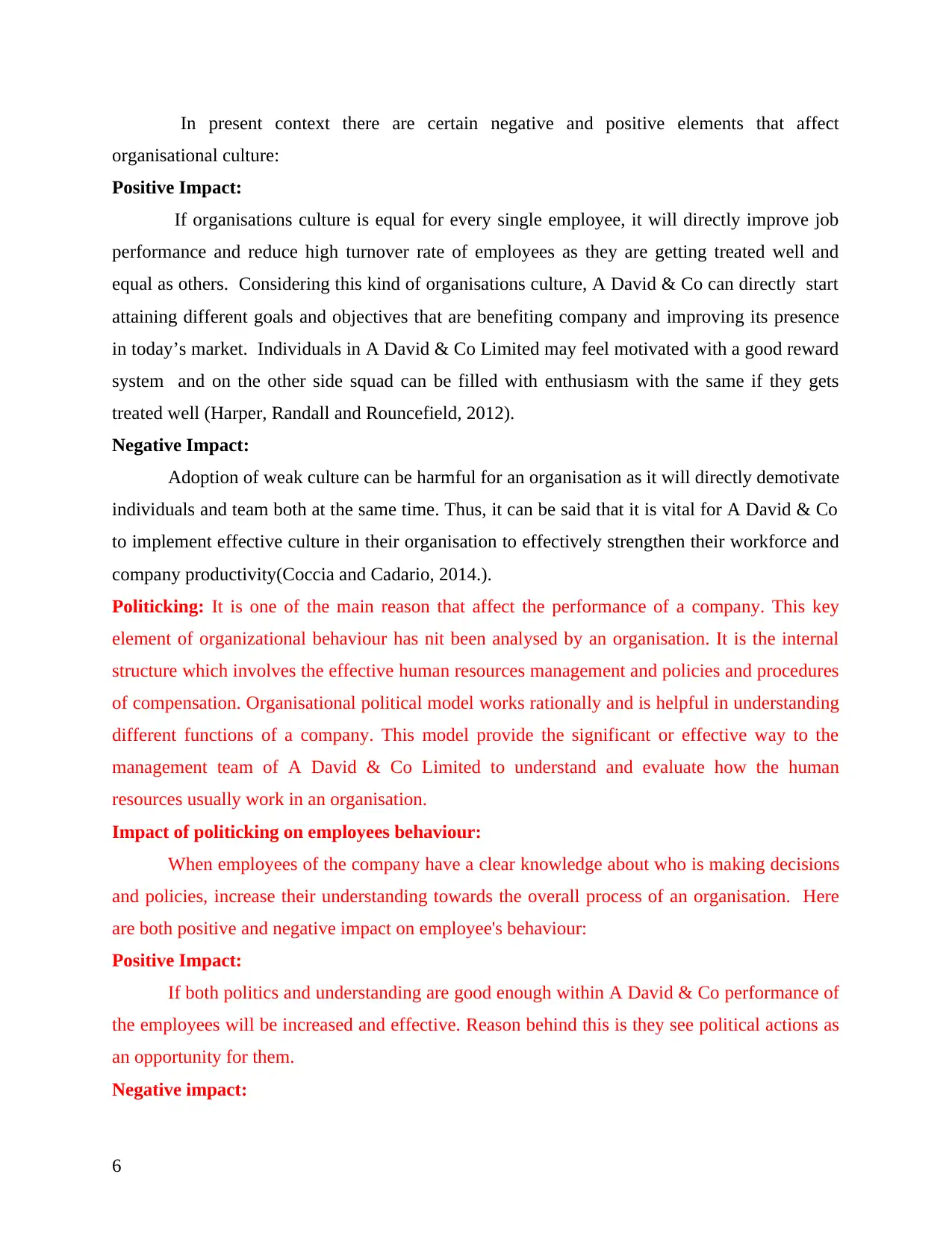
In present context there are certain negative and positive elements that affect
organisational culture:
Positive Impact:
If organisations culture is equal for every single employee, it will directly improve job
performance and reduce high turnover rate of employees as they are getting treated well and
equal as others. Considering this kind of organisations culture, A David & Co can directly start
attaining different goals and objectives that are benefiting company and improving its presence
in today’s market. Individuals in A David & Co Limited may feel motivated with a good reward
system and on the other side squad can be filled with enthusiasm with the same if they gets
treated well (Harper, Randall and Rouncefield, 2012).
Negative Impact:
Adoption of weak culture can be harmful for an organisation as it will directly demotivate
individuals and team both at the same time. Thus, it can be said that it is vital for A David & Co
to implement effective culture in their organisation to effectively strengthen their workforce and
company productivity(Coccia and Cadario, 2014.).
Politicking: It is one of the main reason that affect the performance of a company. This key
element of organizational behaviour has nit been analysed by an organisation. It is the internal
structure which involves the effective human resources management and policies and procedures
of compensation. Organisational political model works rationally and is helpful in understanding
different functions of a company. This model provide the significant or effective way to the
management team of A David & Co Limited to understand and evaluate how the human
resources usually work in an organisation.
Impact of politicking on employees behaviour:
When employees of the company have a clear knowledge about who is making decisions
and policies, increase their understanding towards the overall process of an organisation. Here
are both positive and negative impact on employee's behaviour:
Positive Impact:
If both politics and understanding are good enough within A David & Co performance of
the employees will be increased and effective. Reason behind this is they see political actions as
an opportunity for them.
Negative impact:
6
organisational culture:
Positive Impact:
If organisations culture is equal for every single employee, it will directly improve job
performance and reduce high turnover rate of employees as they are getting treated well and
equal as others. Considering this kind of organisations culture, A David & Co can directly start
attaining different goals and objectives that are benefiting company and improving its presence
in today’s market. Individuals in A David & Co Limited may feel motivated with a good reward
system and on the other side squad can be filled with enthusiasm with the same if they gets
treated well (Harper, Randall and Rouncefield, 2012).
Negative Impact:
Adoption of weak culture can be harmful for an organisation as it will directly demotivate
individuals and team both at the same time. Thus, it can be said that it is vital for A David & Co
to implement effective culture in their organisation to effectively strengthen their workforce and
company productivity(Coccia and Cadario, 2014.).
Politicking: It is one of the main reason that affect the performance of a company. This key
element of organizational behaviour has nit been analysed by an organisation. It is the internal
structure which involves the effective human resources management and policies and procedures
of compensation. Organisational political model works rationally and is helpful in understanding
different functions of a company. This model provide the significant or effective way to the
management team of A David & Co Limited to understand and evaluate how the human
resources usually work in an organisation.
Impact of politicking on employees behaviour:
When employees of the company have a clear knowledge about who is making decisions
and policies, increase their understanding towards the overall process of an organisation. Here
are both positive and negative impact on employee's behaviour:
Positive Impact:
If both politics and understanding are good enough within A David & Co performance of
the employees will be increased and effective. Reason behind this is they see political actions as
an opportunity for them.
Negative impact:
6
⊘ This is a preview!⊘
Do you want full access?
Subscribe today to unlock all pages.

Trusted by 1+ million students worldwide
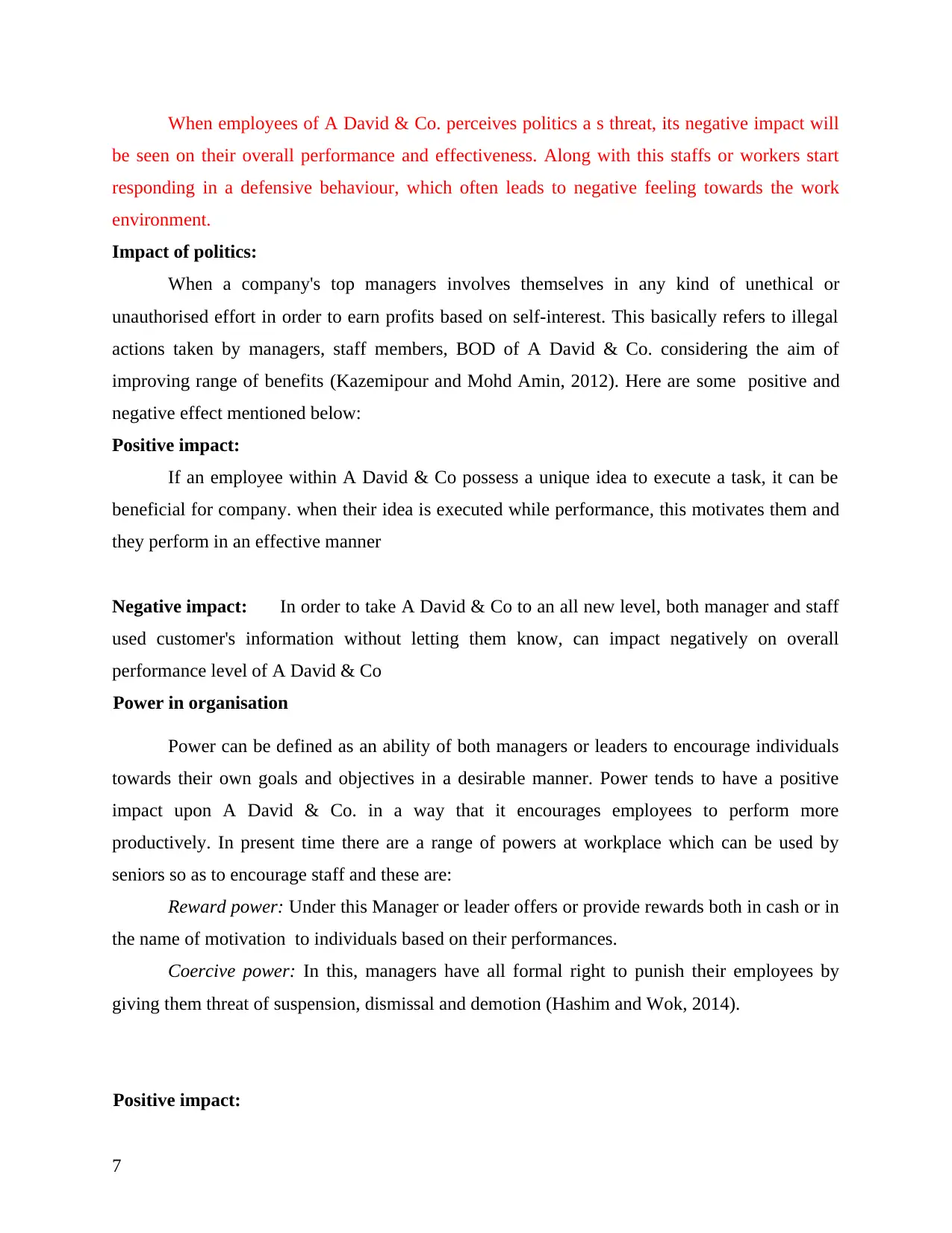
When employees of A David & Co. perceives politics a s threat, its negative impact will
be seen on their overall performance and effectiveness. Along with this staffs or workers start
responding in a defensive behaviour, which often leads to negative feeling towards the work
environment.
Impact of politics:
When a company's top managers involves themselves in any kind of unethical or
unauthorised effort in order to earn profits based on self-interest. This basically refers to illegal
actions taken by managers, staff members, BOD of A David & Co. considering the aim of
improving range of benefits (Kazemipour and Mohd Amin, 2012). Here are some positive and
negative effect mentioned below:
Positive impact:
If an employee within A David & Co possess a unique idea to execute a task, it can be
beneficial for company. when their idea is executed while performance, this motivates them and
they perform in an effective manner
Negative impact: In order to take A David & Co to an all new level, both manager and staff
used customer's information without letting them know, can impact negatively on overall
performance level of A David & Co
Power in organisation
Power can be defined as an ability of both managers or leaders to encourage individuals
towards their own goals and objectives in a desirable manner. Power tends to have a positive
impact upon A David & Co. in a way that it encourages employees to perform more
productively. In present time there are a range of powers at workplace which can be used by
seniors so as to encourage staff and these are:
Reward power: Under this Manager or leader offers or provide rewards both in cash or in
the name of motivation to individuals based on their performances.
Coercive power: In this, managers have all formal right to punish their employees by
giving them threat of suspension, dismissal and demotion (Hashim and Wok, 2014).
Positive impact:
7
be seen on their overall performance and effectiveness. Along with this staffs or workers start
responding in a defensive behaviour, which often leads to negative feeling towards the work
environment.
Impact of politics:
When a company's top managers involves themselves in any kind of unethical or
unauthorised effort in order to earn profits based on self-interest. This basically refers to illegal
actions taken by managers, staff members, BOD of A David & Co. considering the aim of
improving range of benefits (Kazemipour and Mohd Amin, 2012). Here are some positive and
negative effect mentioned below:
Positive impact:
If an employee within A David & Co possess a unique idea to execute a task, it can be
beneficial for company. when their idea is executed while performance, this motivates them and
they perform in an effective manner
Negative impact: In order to take A David & Co to an all new level, both manager and staff
used customer's information without letting them know, can impact negatively on overall
performance level of A David & Co
Power in organisation
Power can be defined as an ability of both managers or leaders to encourage individuals
towards their own goals and objectives in a desirable manner. Power tends to have a positive
impact upon A David & Co. in a way that it encourages employees to perform more
productively. In present time there are a range of powers at workplace which can be used by
seniors so as to encourage staff and these are:
Reward power: Under this Manager or leader offers or provide rewards both in cash or in
the name of motivation to individuals based on their performances.
Coercive power: In this, managers have all formal right to punish their employees by
giving them threat of suspension, dismissal and demotion (Hashim and Wok, 2014).
Positive impact:
7
Paraphrase This Document
Need a fresh take? Get an instant paraphrase of this document with our AI Paraphraser
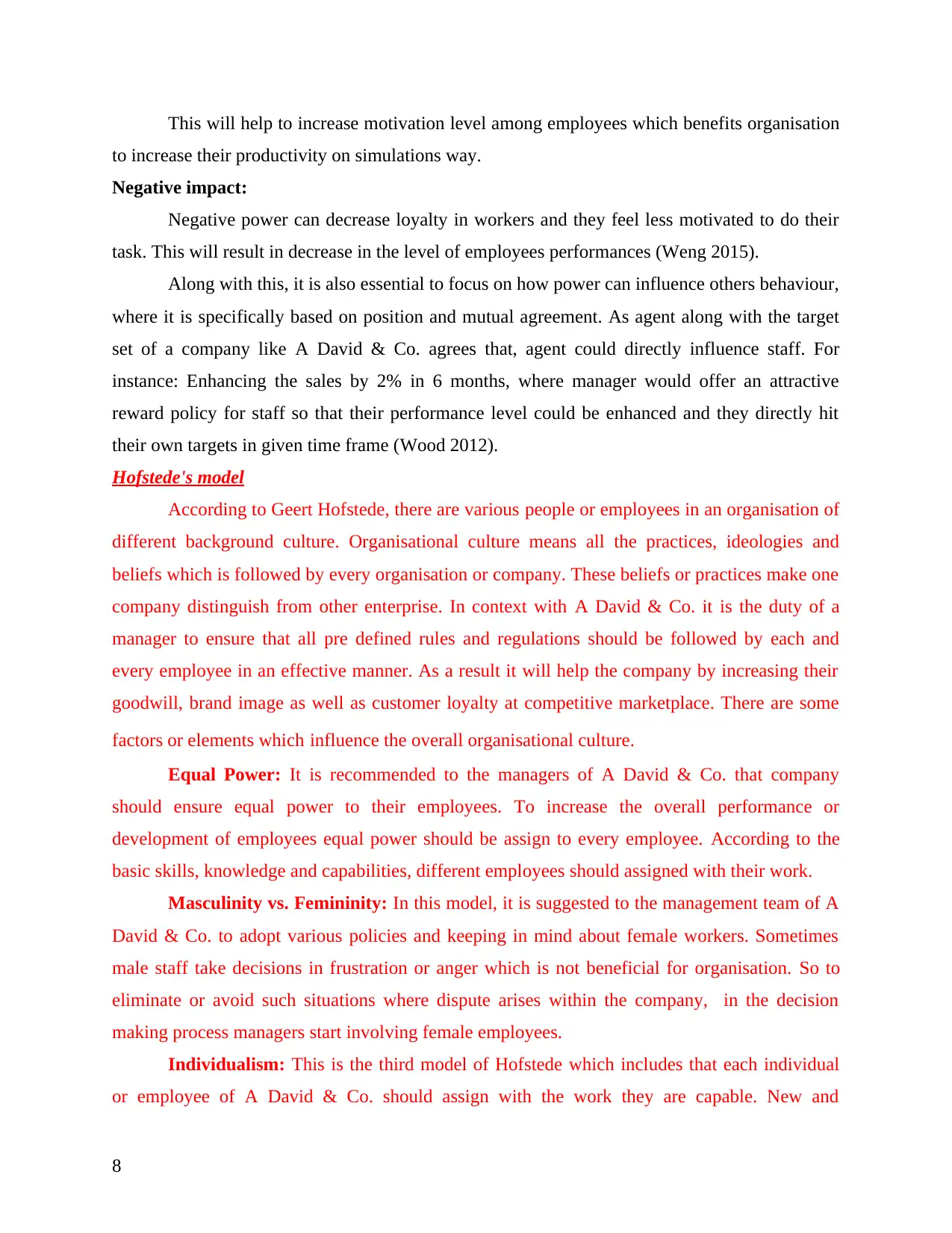
This will help to increase motivation level among employees which benefits organisation
to increase their productivity on simulations way.
Negative impact:
Negative power can decrease loyalty in workers and they feel less motivated to do their
task. This will result in decrease in the level of employees performances (Weng 2015).
Along with this, it is also essential to focus on how power can influence others behaviour,
where it is specifically based on position and mutual agreement. As agent along with the target
set of a company like A David & Co. agrees that, agent could directly influence staff. For
instance: Enhancing the sales by 2% in 6 months, where manager would offer an attractive
reward policy for staff so that their performance level could be enhanced and they directly hit
their own targets in given time frame (Wood 2012).
Hofstede's model
According to Geert Hofstede, there are various people or employees in an organisation of
different background culture. Organisational culture means all the practices, ideologies and
beliefs which is followed by every organisation or company. These beliefs or practices make one
company distinguish from other enterprise. In context with A David & Co. it is the duty of a
manager to ensure that all pre defined rules and regulations should be followed by each and
every employee in an effective manner. As a result it will help the company by increasing their
goodwill, brand image as well as customer loyalty at competitive marketplace. There are some
factors or elements which influence the overall organisational culture.
Equal Power: It is recommended to the managers of A David & Co. that company
should ensure equal power to their employees. To increase the overall performance or
development of employees equal power should be assign to every employee. According to the
basic skills, knowledge and capabilities, different employees should assigned with their work.
Masculinity vs. Femininity: In this model, it is suggested to the management team of A
David & Co. to adopt various policies and keeping in mind about female workers. Sometimes
male staff take decisions in frustration or anger which is not beneficial for organisation. So to
eliminate or avoid such situations where dispute arises within the company, in the decision
making process managers start involving female employees.
Individualism: This is the third model of Hofstede which includes that each individual
or employee of A David & Co. should assign with the work they are capable. New and
8
to increase their productivity on simulations way.
Negative impact:
Negative power can decrease loyalty in workers and they feel less motivated to do their
task. This will result in decrease in the level of employees performances (Weng 2015).
Along with this, it is also essential to focus on how power can influence others behaviour,
where it is specifically based on position and mutual agreement. As agent along with the target
set of a company like A David & Co. agrees that, agent could directly influence staff. For
instance: Enhancing the sales by 2% in 6 months, where manager would offer an attractive
reward policy for staff so that their performance level could be enhanced and they directly hit
their own targets in given time frame (Wood 2012).
Hofstede's model
According to Geert Hofstede, there are various people or employees in an organisation of
different background culture. Organisational culture means all the practices, ideologies and
beliefs which is followed by every organisation or company. These beliefs or practices make one
company distinguish from other enterprise. In context with A David & Co. it is the duty of a
manager to ensure that all pre defined rules and regulations should be followed by each and
every employee in an effective manner. As a result it will help the company by increasing their
goodwill, brand image as well as customer loyalty at competitive marketplace. There are some
factors or elements which influence the overall organisational culture.
Equal Power: It is recommended to the managers of A David & Co. that company
should ensure equal power to their employees. To increase the overall performance or
development of employees equal power should be assign to every employee. According to the
basic skills, knowledge and capabilities, different employees should assigned with their work.
Masculinity vs. Femininity: In this model, it is suggested to the management team of A
David & Co. to adopt various policies and keeping in mind about female workers. Sometimes
male staff take decisions in frustration or anger which is not beneficial for organisation. So to
eliminate or avoid such situations where dispute arises within the company, in the decision
making process managers start involving female employees.
Individualism: This is the third model of Hofstede which includes that each individual
or employee of A David & Co. should assign with the work they are capable. New and
8
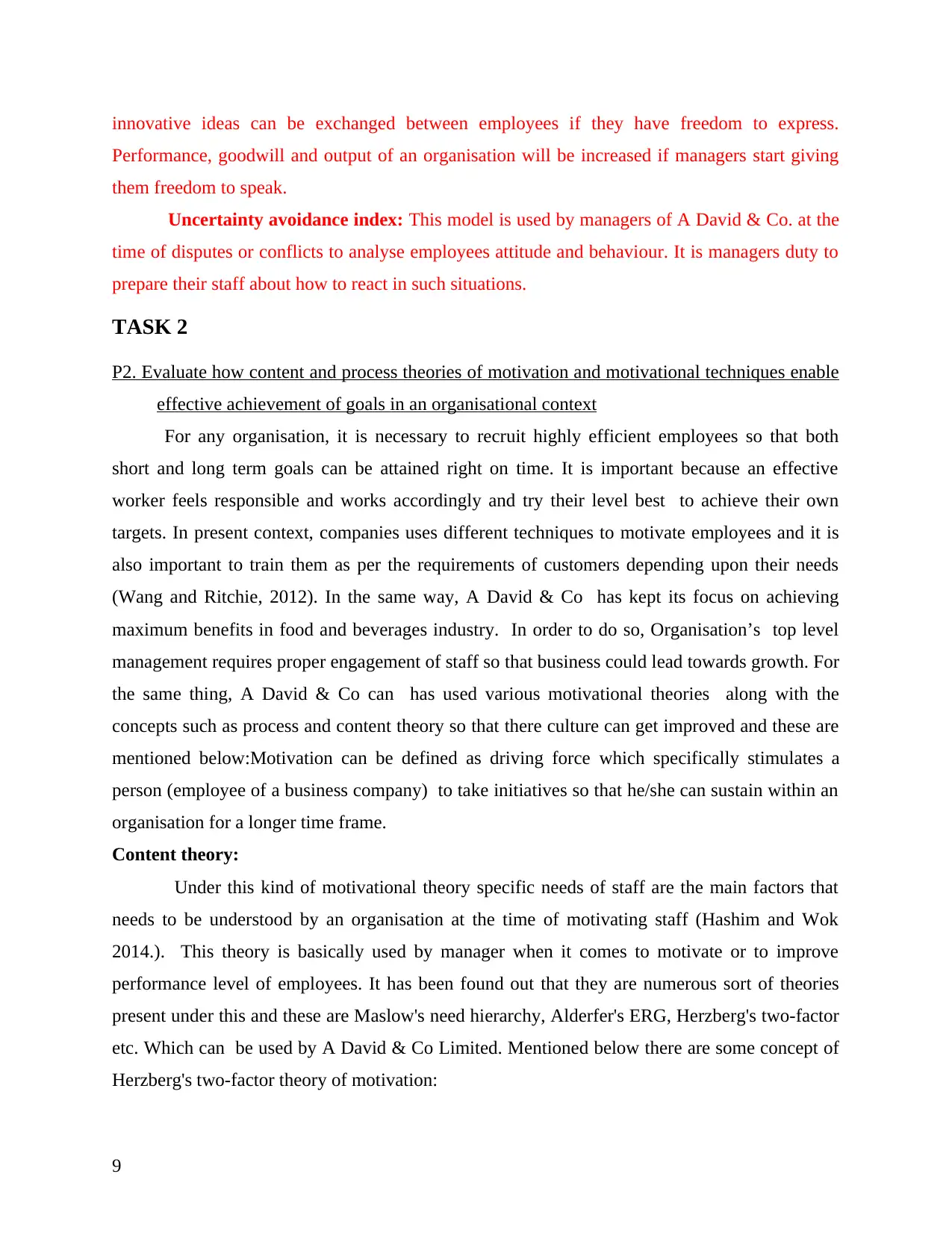
innovative ideas can be exchanged between employees if they have freedom to express.
Performance, goodwill and output of an organisation will be increased if managers start giving
them freedom to speak.
Uncertainty avoidance index: This model is used by managers of A David & Co. at the
time of disputes or conflicts to analyse employees attitude and behaviour. It is managers duty to
prepare their staff about how to react in such situations.
TASK 2
P2. Evaluate how content and process theories of motivation and motivational techniques enable
effective achievement of goals in an organisational context
For any organisation, it is necessary to recruit highly efficient employees so that both
short and long term goals can be attained right on time. It is important because an effective
worker feels responsible and works accordingly and try their level best to achieve their own
targets. In present context, companies uses different techniques to motivate employees and it is
also important to train them as per the requirements of customers depending upon their needs
(Wang and Ritchie, 2012). In the same way, A David & Co has kept its focus on achieving
maximum benefits in food and beverages industry. In order to do so, Organisation’s top level
management requires proper engagement of staff so that business could lead towards growth. For
the same thing, A David & Co can has used various motivational theories along with the
concepts such as process and content theory so that there culture can get improved and these are
mentioned below:Motivation can be defined as driving force which specifically stimulates a
person (employee of a business company) to take initiatives so that he/she can sustain within an
organisation for a longer time frame.
Content theory:
Under this kind of motivational theory specific needs of staff are the main factors that
needs to be understood by an organisation at the time of motivating staff (Hashim and Wok
2014.). This theory is basically used by manager when it comes to motivate or to improve
performance level of employees. It has been found out that they are numerous sort of theories
present under this and these are Maslow's need hierarchy, Alderfer's ERG, Herzberg's two-factor
etc. Which can be used by A David & Co Limited. Mentioned below there are some concept of
Herzberg's two-factor theory of motivation:
9
Performance, goodwill and output of an organisation will be increased if managers start giving
them freedom to speak.
Uncertainty avoidance index: This model is used by managers of A David & Co. at the
time of disputes or conflicts to analyse employees attitude and behaviour. It is managers duty to
prepare their staff about how to react in such situations.
TASK 2
P2. Evaluate how content and process theories of motivation and motivational techniques enable
effective achievement of goals in an organisational context
For any organisation, it is necessary to recruit highly efficient employees so that both
short and long term goals can be attained right on time. It is important because an effective
worker feels responsible and works accordingly and try their level best to achieve their own
targets. In present context, companies uses different techniques to motivate employees and it is
also important to train them as per the requirements of customers depending upon their needs
(Wang and Ritchie, 2012). In the same way, A David & Co has kept its focus on achieving
maximum benefits in food and beverages industry. In order to do so, Organisation’s top level
management requires proper engagement of staff so that business could lead towards growth. For
the same thing, A David & Co can has used various motivational theories along with the
concepts such as process and content theory so that there culture can get improved and these are
mentioned below:Motivation can be defined as driving force which specifically stimulates a
person (employee of a business company) to take initiatives so that he/she can sustain within an
organisation for a longer time frame.
Content theory:
Under this kind of motivational theory specific needs of staff are the main factors that
needs to be understood by an organisation at the time of motivating staff (Hashim and Wok
2014.). This theory is basically used by manager when it comes to motivate or to improve
performance level of employees. It has been found out that they are numerous sort of theories
present under this and these are Maslow's need hierarchy, Alderfer's ERG, Herzberg's two-factor
etc. Which can be used by A David & Co Limited. Mentioned below there are some concept of
Herzberg's two-factor theory of motivation:
9
⊘ This is a preview!⊘
Do you want full access?
Subscribe today to unlock all pages.

Trusted by 1+ million students worldwide
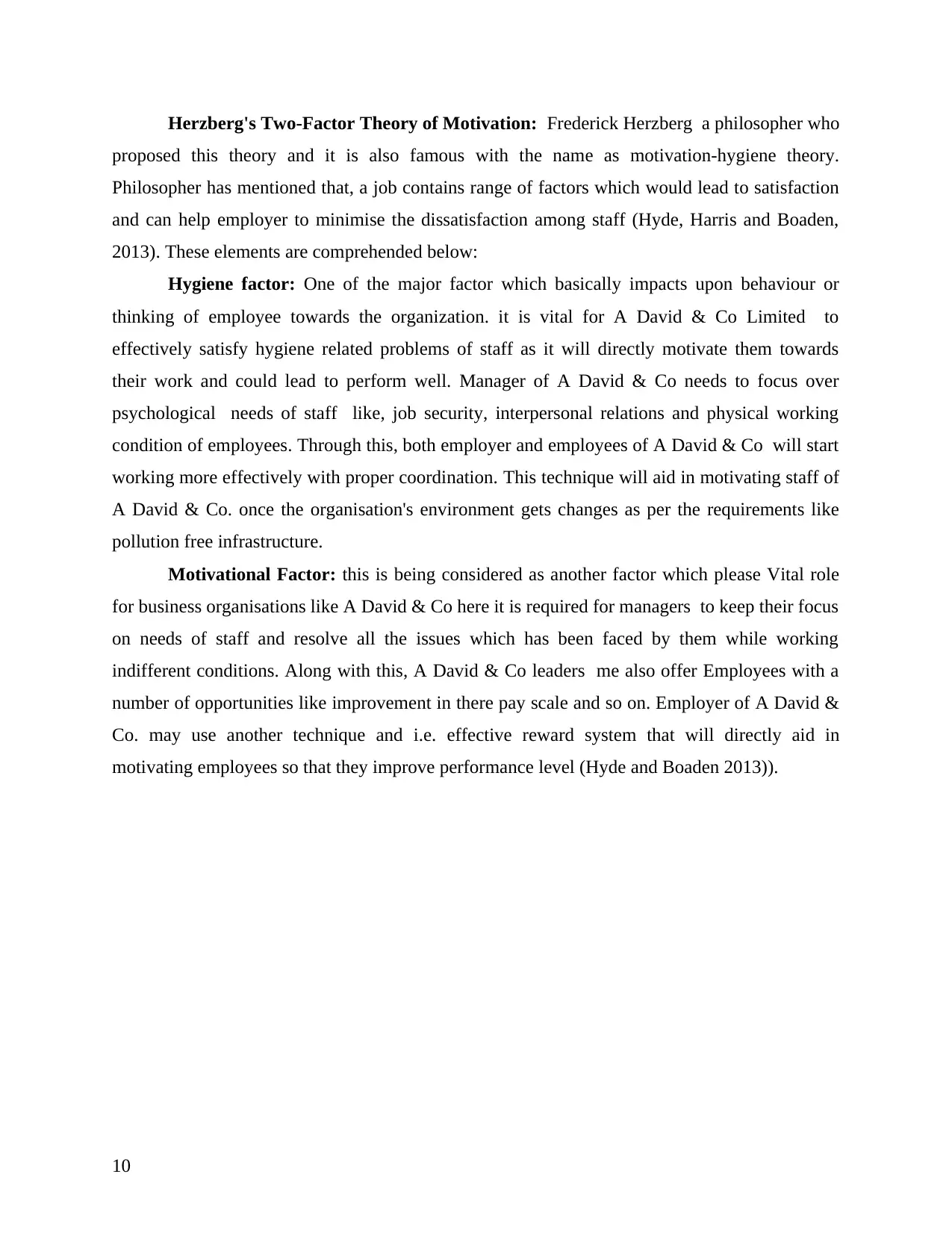
Herzberg's Two-Factor Theory of Motivation: Frederick Herzberg a philosopher who
proposed this theory and it is also famous with the name as motivation-hygiene theory.
Philosopher has mentioned that, a job contains range of factors which would lead to satisfaction
and can help employer to minimise the dissatisfaction among staff (Hyde, Harris and Boaden,
2013). These elements are comprehended below:
Hygiene factor: One of the major factor which basically impacts upon behaviour or
thinking of employee towards the organization. it is vital for A David & Co Limited to
effectively satisfy hygiene related problems of staff as it will directly motivate them towards
their work and could lead to perform well. Manager of A David & Co needs to focus over
psychological needs of staff like, job security, interpersonal relations and physical working
condition of employees. Through this, both employer and employees of A David & Co will start
working more effectively with proper coordination. This technique will aid in motivating staff of
A David & Co. once the organisation's environment gets changes as per the requirements like
pollution free infrastructure.
Motivational Factor: this is being considered as another factor which please Vital role
for business organisations like A David & Co here it is required for managers to keep their focus
on needs of staff and resolve all the issues which has been faced by them while working
indifferent conditions. Along with this, A David & Co leaders me also offer Employees with a
number of opportunities like improvement in there pay scale and so on. Employer of A David &
Co. may use another technique and i.e. effective reward system that will directly aid in
motivating employees so that they improve performance level (Hyde and Boaden 2013)).
10
proposed this theory and it is also famous with the name as motivation-hygiene theory.
Philosopher has mentioned that, a job contains range of factors which would lead to satisfaction
and can help employer to minimise the dissatisfaction among staff (Hyde, Harris and Boaden,
2013). These elements are comprehended below:
Hygiene factor: One of the major factor which basically impacts upon behaviour or
thinking of employee towards the organization. it is vital for A David & Co Limited to
effectively satisfy hygiene related problems of staff as it will directly motivate them towards
their work and could lead to perform well. Manager of A David & Co needs to focus over
psychological needs of staff like, job security, interpersonal relations and physical working
condition of employees. Through this, both employer and employees of A David & Co will start
working more effectively with proper coordination. This technique will aid in motivating staff of
A David & Co. once the organisation's environment gets changes as per the requirements like
pollution free infrastructure.
Motivational Factor: this is being considered as another factor which please Vital role
for business organisations like A David & Co here it is required for managers to keep their focus
on needs of staff and resolve all the issues which has been faced by them while working
indifferent conditions. Along with this, A David & Co leaders me also offer Employees with a
number of opportunities like improvement in there pay scale and so on. Employer of A David &
Co. may use another technique and i.e. effective reward system that will directly aid in
motivating employees so that they improve performance level (Hyde and Boaden 2013)).
10
Paraphrase This Document
Need a fresh take? Get an instant paraphrase of this document with our AI Paraphraser
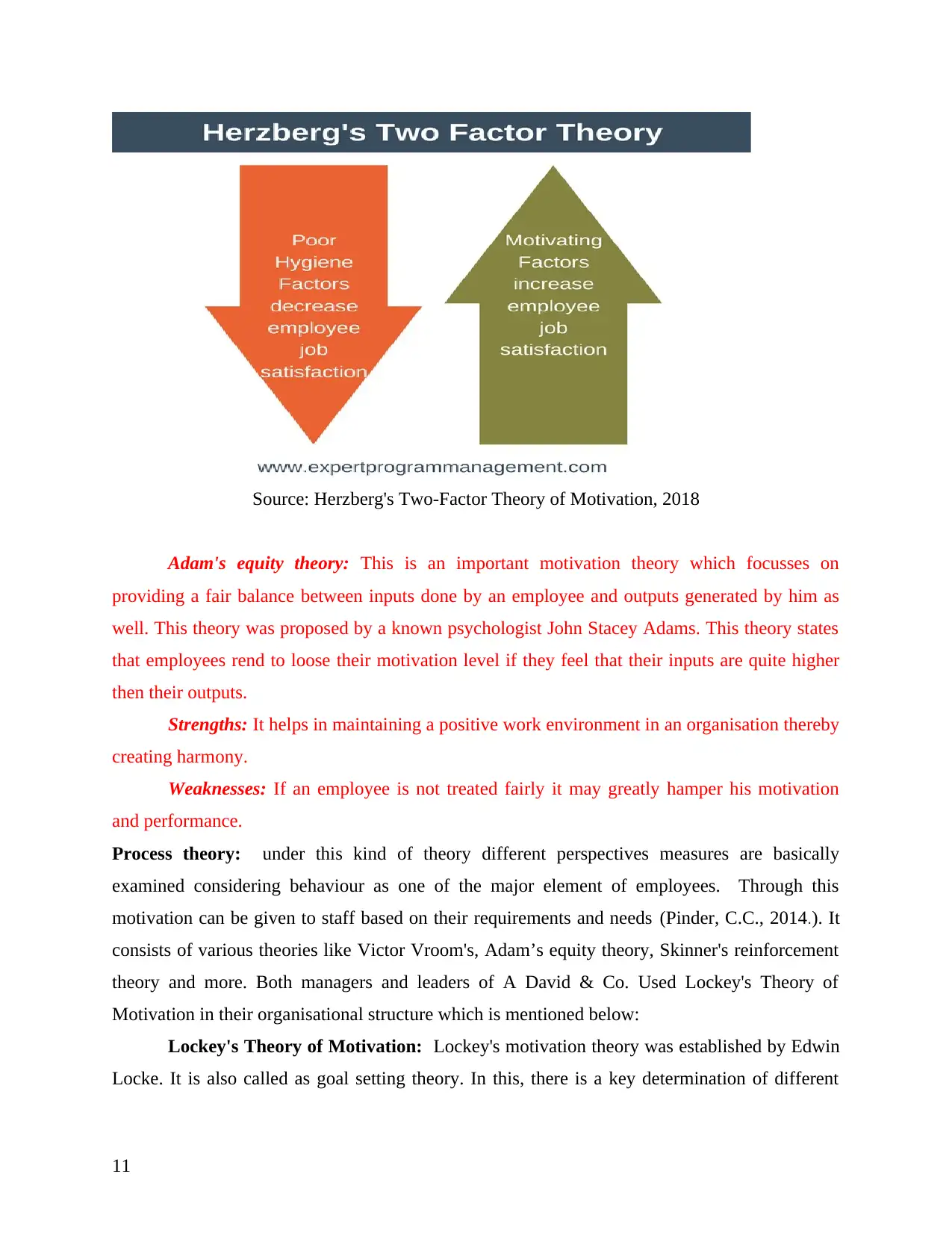
Source: Herzberg's Two-Factor Theory of Motivation, 2018
Adam's equity theory: This is an important motivation theory which focusses on
providing a fair balance between inputs done by an employee and outputs generated by him as
well. This theory was proposed by a known psychologist John Stacey Adams. This theory states
that employees rend to loose their motivation level if they feel that their inputs are quite higher
then their outputs.
Strengths: It helps in maintaining a positive work environment in an organisation thereby
creating harmony.
Weaknesses: If an employee is not treated fairly it may greatly hamper his motivation
and performance.
Process theory: under this kind of theory different perspectives measures are basically
examined considering behaviour as one of the major element of employees. Through this
motivation can be given to staff based on their requirements and needs (Pinder, C.C., 2014.). It
consists of various theories like Victor Vroom's, Adam’s equity theory, Skinner's reinforcement
theory and more. Both managers and leaders of A David & Co. Used Lockey's Theory of
Motivation in their organisational structure which is mentioned below:
Lockey's Theory of Motivation: Lockey's motivation theory was established by Edwin
Locke. It is also called as goal setting theory. In this, there is a key determination of different
11
Adam's equity theory: This is an important motivation theory which focusses on
providing a fair balance between inputs done by an employee and outputs generated by him as
well. This theory was proposed by a known psychologist John Stacey Adams. This theory states
that employees rend to loose their motivation level if they feel that their inputs are quite higher
then their outputs.
Strengths: It helps in maintaining a positive work environment in an organisation thereby
creating harmony.
Weaknesses: If an employee is not treated fairly it may greatly hamper his motivation
and performance.
Process theory: under this kind of theory different perspectives measures are basically
examined considering behaviour as one of the major element of employees. Through this
motivation can be given to staff based on their requirements and needs (Pinder, C.C., 2014.). It
consists of various theories like Victor Vroom's, Adam’s equity theory, Skinner's reinforcement
theory and more. Both managers and leaders of A David & Co. Used Lockey's Theory of
Motivation in their organisational structure which is mentioned below:
Lockey's Theory of Motivation: Lockey's motivation theory was established by Edwin
Locke. It is also called as goal setting theory. In this, there is a key determination of different
11
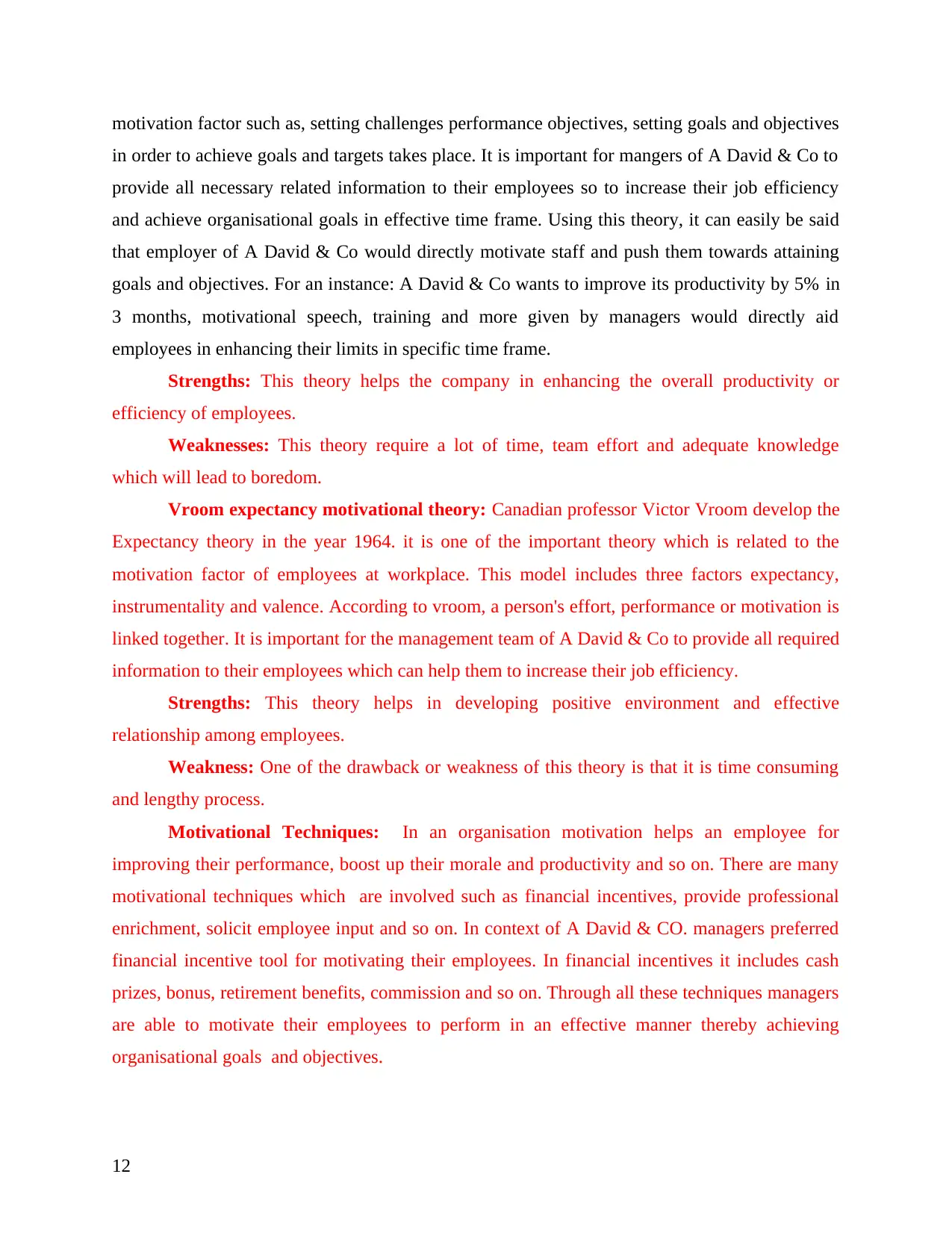
motivation factor such as, setting challenges performance objectives, setting goals and objectives
in order to achieve goals and targets takes place. It is important for mangers of A David & Co to
provide all necessary related information to their employees so to increase their job efficiency
and achieve organisational goals in effective time frame. Using this theory, it can easily be said
that employer of A David & Co would directly motivate staff and push them towards attaining
goals and objectives. For an instance: A David & Co wants to improve its productivity by 5% in
3 months, motivational speech, training and more given by managers would directly aid
employees in enhancing their limits in specific time frame.
Strengths: This theory helps the company in enhancing the overall productivity or
efficiency of employees.
Weaknesses: This theory require a lot of time, team effort and adequate knowledge
which will lead to boredom.
Vroom expectancy motivational theory: Canadian professor Victor Vroom develop the
Expectancy theory in the year 1964. it is one of the important theory which is related to the
motivation factor of employees at workplace. This model includes three factors expectancy,
instrumentality and valence. According to vroom, a person's effort, performance or motivation is
linked together. It is important for the management team of A David & Co to provide all required
information to their employees which can help them to increase their job efficiency.
Strengths: This theory helps in developing positive environment and effective
relationship among employees.
Weakness: One of the drawback or weakness of this theory is that it is time consuming
and lengthy process.
Motivational Techniques: In an organisation motivation helps an employee for
improving their performance, boost up their morale and productivity and so on. There are many
motivational techniques which are involved such as financial incentives, provide professional
enrichment, solicit employee input and so on. In context of A David & CO. managers preferred
financial incentive tool for motivating their employees. In financial incentives it includes cash
prizes, bonus, retirement benefits, commission and so on. Through all these techniques managers
are able to motivate their employees to perform in an effective manner thereby achieving
organisational goals and objectives.
12
in order to achieve goals and targets takes place. It is important for mangers of A David & Co to
provide all necessary related information to their employees so to increase their job efficiency
and achieve organisational goals in effective time frame. Using this theory, it can easily be said
that employer of A David & Co would directly motivate staff and push them towards attaining
goals and objectives. For an instance: A David & Co wants to improve its productivity by 5% in
3 months, motivational speech, training and more given by managers would directly aid
employees in enhancing their limits in specific time frame.
Strengths: This theory helps the company in enhancing the overall productivity or
efficiency of employees.
Weaknesses: This theory require a lot of time, team effort and adequate knowledge
which will lead to boredom.
Vroom expectancy motivational theory: Canadian professor Victor Vroom develop the
Expectancy theory in the year 1964. it is one of the important theory which is related to the
motivation factor of employees at workplace. This model includes three factors expectancy,
instrumentality and valence. According to vroom, a person's effort, performance or motivation is
linked together. It is important for the management team of A David & Co to provide all required
information to their employees which can help them to increase their job efficiency.
Strengths: This theory helps in developing positive environment and effective
relationship among employees.
Weakness: One of the drawback or weakness of this theory is that it is time consuming
and lengthy process.
Motivational Techniques: In an organisation motivation helps an employee for
improving their performance, boost up their morale and productivity and so on. There are many
motivational techniques which are involved such as financial incentives, provide professional
enrichment, solicit employee input and so on. In context of A David & CO. managers preferred
financial incentive tool for motivating their employees. In financial incentives it includes cash
prizes, bonus, retirement benefits, commission and so on. Through all these techniques managers
are able to motivate their employees to perform in an effective manner thereby achieving
organisational goals and objectives.
12
⊘ This is a preview!⊘
Do you want full access?
Subscribe today to unlock all pages.

Trusted by 1+ million students worldwide
1 out of 19
Related Documents
Your All-in-One AI-Powered Toolkit for Academic Success.
+13062052269
info@desklib.com
Available 24*7 on WhatsApp / Email
![[object Object]](/_next/static/media/star-bottom.7253800d.svg)
Unlock your academic potential
Copyright © 2020–2025 A2Z Services. All Rights Reserved. Developed and managed by ZUCOL.





